Timeline: Tiananmen protests
- Published

The 1989 Tiananmen protests were the greatest challenge China's communist rulers had faced
In the spring of 1989, more than one million Chinese students and workers occupied Beijing's Tiananmen Square and began the largest political protest in communist China's history. Six weeks of protests ended with the Beijing massacre of 3-4 June.
15 April: Hu Yaobang's death
Former Communist Party chief Hu Yaobang, a leading reformist, dies of a heart attack aged 73. Mourners begin to gather in Beijing's Tiananmen Square. They are expressing their sadness, but also their dissatisfaction with the pace of reform in China.
18-21 April: Demonstrations spread
Numbers in Beijing swell into thousands in the following days, and demonstrations spread to cities and universities nationwide.
Students, workers and officials shout slogans calling for greater freedom and democracy and an end to what they called dictatorship - others complain about inflation, salaries and housing.
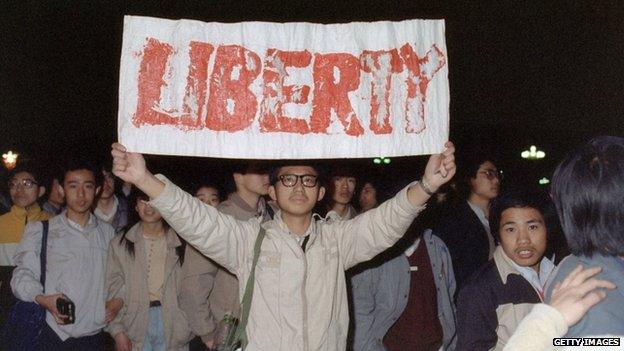
An editorial in the People's Daily newspaper further fuels public anger
22 April: Hu's memorial
Tens of thousands of students gather outside the Great Hall of the People in Tiananmen Square as Hu's memorial service is held.
Their actions come in spite of an earlier warning by the city government that protesters risk severe punishment.
They deliver a petition of demands and insist on a meeting with Li Peng - China's premier at the time - which is rejected.
26 April: Inflammatory editorial
The state-run newspaper, the People's Daily, publishes an editorial entitled The Necessity for a Clear Stand Against Turmoil, accusing the protesters of rejecting the Communist Party.
The article closely mirrors views expressed by Deng Xiaoping, China's unofficial leader. It further fuels public anger.
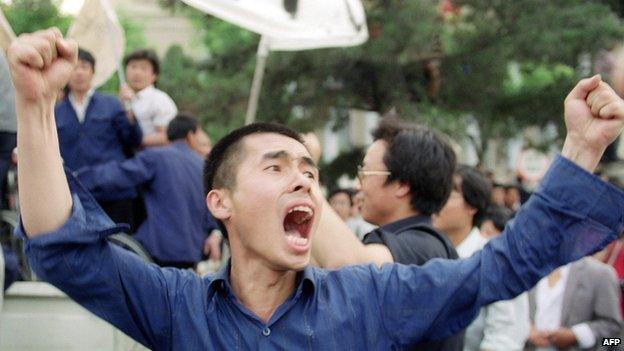
Tens of thousands of Chinese students in at least five cities stage protests
4 May: Numbers rise
Tens of thousands of Chinese students in at least five cities stage the biggest pro-democracy demonstrations of their kind since the communists came to power 40 years ago.
The action coincides with the 70th anniversary of the 4 May movement, an intellectual movement that wanted a stronger China.
But at a meeting with Asian bankers Zhao Ziyang, the official head of the Communist Party, says the protests will gradually subside.
13 May: Hunger strike
Ahead of a visit by Soviet leader Mikhail Gorbachev, hundreds of students begin an indefinite hunger strike in Tiananmen Square, pressing for political reforms.
They blame their extreme action on the government's failure to respond to their requests for dialogue. The move draws broad public support.
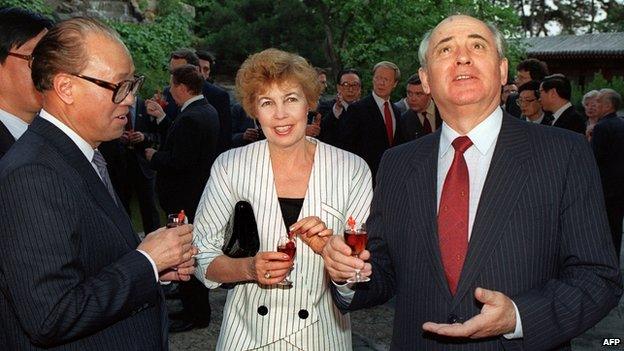
Soviet leader Mikhail Gorbachev, right, arrived in Beijing in May 1989
15 May: Gorbachev's state visit
Mikhail Gorbachev arrives in Beijing for the first Sino-Soviet summit in 30 years. His visit is intended to put a formal end to years of hostility between the two communist nations.
The protests force the authorities to cancel plans to welcome him in Tiananmen Square - a huge embarrassment for the government.
19 May: Zhao visits square
Zhao Ziyang visits students on Tiananmen Square, and makes a final, unsuccessful appeal for a compromise.
Zhao is accompanied by Li Peng, his hard-line rival, and Wen Jiabao, who will eventually become China's premier in the future.
Zhao, who wanted China to introduce far-reaching political reforms, reportedly told the crowd: "We have come too late." It was to be one of his last political acts.
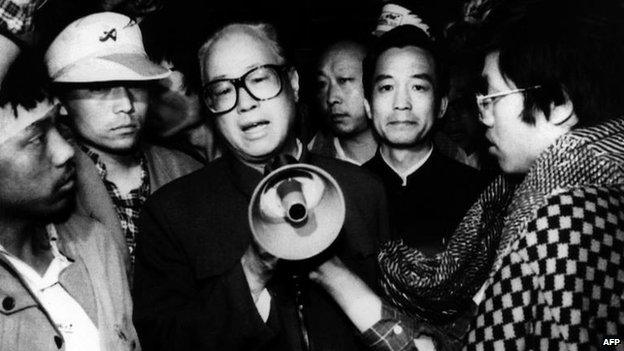
Zhao Ziyang, centre, did not succeed in his appeal for a compromise
20 May: Troops move in
Martial law is declared in several districts in Beijing and troops move towards the city centre.
A huge number of civilians block their convoys, setting up barricades on streets. The soldiers have been ordered not to fire on civilians.
24 May to 1 June: Heightened tensions
Over the next week, demonstrations continue with almost no visible security presence - there is a jubilant atmosphere in Tiananmen Square.
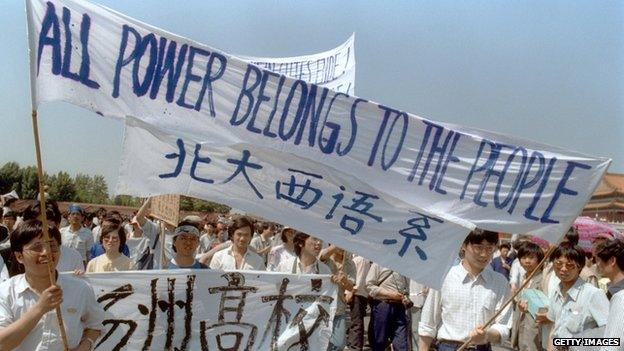
Students, workers and officials take to the streets to ask for greater freedom and democracy
However, at government headquarters China's leaders plan a new offensive to end the demonstrations and end the chaos in China's capital.
2 June: Offensive approved
Communist Party elders approve the decision to put down the "counter-revolutionary riot" by force.
3 June: Night of bloodshed
Kate Adie reports as Chinese troops fire on protesters
In the evening, thousands of PLA soldiers begin moving towards the centre of Beijing. People flood on to the streets to try to block them, setting up barricades along routes into Tiananmen Square.
As the army tries to break through in armoured personnel carriers, some troops open fire with guns loaded with live ammunition, killing and injuring many unarmed citizens.
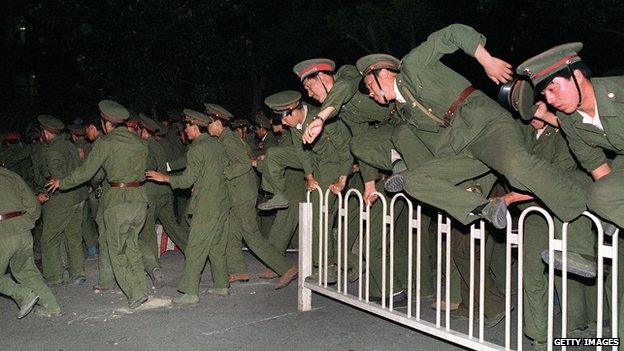
The government hailed the military's intervention as a victory
4 June: Anger and shock
Tiananmen Square is cleared after a night of the worst bloodshed ever seen in Beijing under communist rule.
As the new day begins, the capital is in a state of shock. Thousands of angry and curious residents crowd up to lines of soldiers blocking the north-east entrance. The soldiers open fire again.
There is sporadic gunfire throughout the day.
The government hails the military intervention as a great victory. An editorial is published saying the army would severely and mercilessly punish "lawless people who plan riots and disturb social order".
But Peking Radio's English language service, in an act of defiance, says thousands of innocent civilians were killed. The government-run radio calls the act a gross violation of human rights and a barbarous suppression of the people.
Afterwards the authorities claim no-one was shot dead in the square itself. There is still debate about exactly how many people were killed. Some say a few hundred, others say a few thousand.
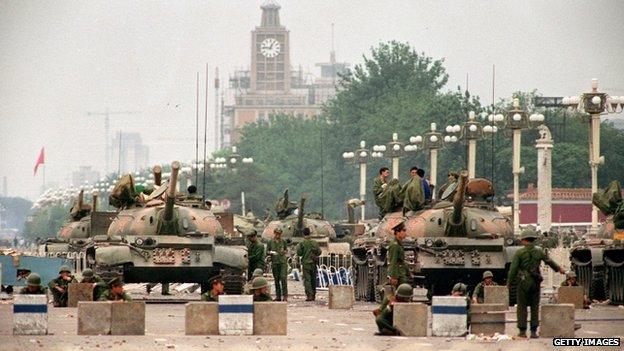
Tiananmen Square was cleared after a night of the worst bloodshed ever seen in Beijing
5 June: 'Tank man'
The army now has complete control of Beijing. But the world witnesses a staggering act of defiance - the unarmed man blocking a column of tanks as they moved along Chang'an Avenue towards Tiananmen Square.
To this day, the fate of the man remains unknown.
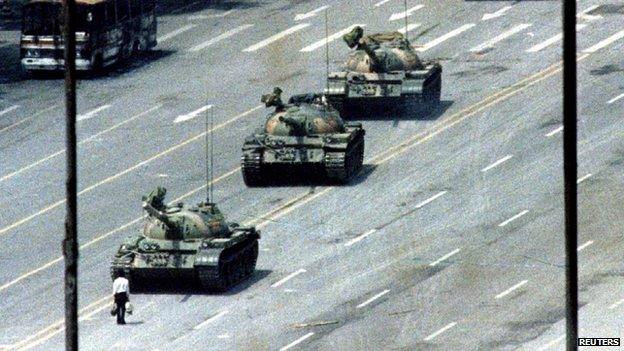
This image, of a lone man in front of tanks, is now known around the world
9 June: Deng Xiaoping appears
China's paramount leader Deng Xiaoping appears for the first time since the brutal crackdown.
In a speech to military officers he praises their efforts, and blames the turmoil on counter-revolutionaries who wanted nothing less than to overthrow communism.
Brian Barron reports on Deng Xiaoping's first appearance since the Tiananmen massacre